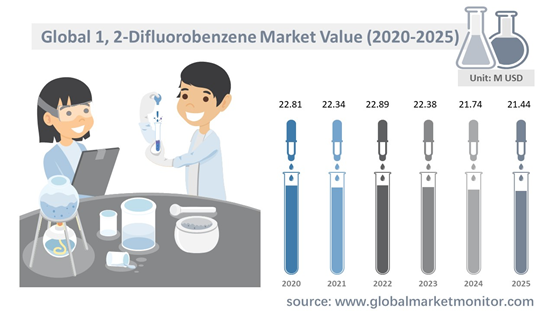1,2-Difluorobenzene is an aromatic compound with the molecular formula C6H4F2. It is a colorless liquid that can be used as a solvent for electrochemical studies of transition metal complexes. It is relatively chemically inert and has a high enough dielectric constant to dissolve many electrolytes and metal complexes. It is used as a weakly coordinated solvent for metal complexes, replacing the relatively strongly coordinated solvents acetonitrile, DMSO and DMF.
In terms of purity, 1,2-difluorobenzene can be classified as 99.5%, 99.8% and others, and others include 99% and 98%. 99.8% 1,2-difluorobenzene has the highest purity and the lowest impurity content, which is suitable for important and precise analytical and scientific work, and is generally used as reagent. 99.5% and 99% 1,2-difluorobenzene is usually used as pharmaceutical intermediates, and is also suitable for general analytical work in industry and schools. While 98% 1, 2-difluorobenzene is commonly used as an intermediate in dyes, pesticides and synthetic materials. In 2019, the market value of 99.5% 1, 2-difluorobenzene has reached $11.32 million, which is the highest market value type among all 1, 2-difluorobenzene.
1,2-Difluorobenzene has a wide range of applications and is currently used in pesticides, medicine, and dyes. The application in the industry of medicine has the largest market share. 1,2-Difluorobenzene is used as a pharmaceutical intermediate and twenty percent of all commercially available drugs contain fluorine, which is used in drugs for diagnosis, treatment, prevention, or pain relief and is vital to the human body. The growing pharmaceutical industry is driving the 1,2-difluorobenzene market, which has reached a market value of $12.87 million in 2019. The application is expected to expand its market share in medicine to 48.97% by 2025 from 46.92% in 2019.
Global 1,2-Difluorobenzene Market Status and Prospect Analysis
1, 2-Difluorobenzene companies are mainly from China, and the industry concentration is high. The top three companies are Zhejiang Yongtai Technology CO., Ltd, Zhejiang Xieshi New Materials Co., Ltd, Haihang Industry Co., Ltd. with the revenue market share of 26.56%, 5.50%, 5.36% in 2019.
Asia Pacific is the largest revenue market with 45.31% market share in 2015 and 46.51% in 2019, an increase of 1.2% year on year. As the largest producer of 1,2-difluorobenzene, China has imposed strict controls on the industry with the enactment of the Regulations on Safety Management of Hazardous Chemicals. The introduction of this regulation has strengthened the safety management of hazardous chemicals, prevented and reduced the occurrence of hazardous chemical accidents, and protected public lives and properties. However, strict industry regulation may hinder the development of the industry to a certain extent. The 1,2-difluorobenzene market in China is expected to decline to $5.78 million by 2025, from $5.98 million in 2019.
Get the complete sample, please click: https://www.globalmarketmonitor.com/reports/762569-1,2-difluorobenzene-market-report.html
North America has developed a mature industry chain due to its advanced technology and high consumption capacity. In 2019, its market share was 24.18%, ranking second in the world. Europe ranked third with 19.85%.
The Epidemic to Hinder the Global 1,2-Difluorobenzene Market

According to research, the global 1,2-difluorobenzene market generated total revenue of $25.88 million in 2015, decreasing to $22.81 million in 2020. The 1,2-difluorobenzene market is forecast to be worth $21.44 million by 2025. 1,2-difluorobenzene is projected to grow at a CAGR of -1.23% from 2020 to 2025.
The epidemic swept the global energy market and its downstream petrochemical derivatives, posing a huge challenge to the 1,2-difluorobenzene industry in terms of resumption of production, sales operations and industry development. Prices of basic chemicals, especially benzene, are closely related to crude oil, and spot prices are still on a downward trend in value across the market as crude oil prices fall and hardly rise rapidly. Most of the downstream end-user product plants are set to close. Now that the government is taking strict measures to curb the spread of the virus, recovery plans for these downstream industries will continue to be forced to be delayed.
1,2-Difluorobenzene is commonly used as an industrial intermediate in the production of various agrochemicals. Because 1,2-difluorobenzene is a non-coordinated chemical solvent and relatively inert, it can be an effective solvent for and otherwise inaccessible intermediates. 1,2-difluorobenzene has outstanding advantages as a solvent and the industry outlook is very promising.
However, when 1,2-difluorobenzene is used as a weak coordination solvent for metal complexes, there are more alternative coordination solvents such as acetonitrile, DMSO, and DMF, which are developing to capture the market share of 1,2-difluorobenzene, posing a challenge to the development of the 1,2-difluorobenzene industry. In addition, 1,2-difluorobenzene burns when exposed to an open flame and emits toxic and flammable gases when heated. 1,2-difluorobenzene is a highly flammable liquid and must be used away from heat sources, hot surfaces, sparks, open flames and other ignition sources. 1,2-difluorobenzene is harmful and irritating to the body when inhaled, taken internally or absorbed through the skin. At the same time, 1,2-difluorobenzene may cause fluorine contamination and serious environmental pollution. Excessive intake of fluoride can interfere with the activity of various enzymes in the body, disrupt the metabolic balance of calcium and phosphorus, and cause symptoms such as brittle teeth, dental plaque, and bone and joint deformities. Therefore 1,2-difluorobenzene is extremely dangerous as a chemical, which is detrimental to the further development of the industry.
Get the complete sample, please click: https://www.globalmarketmonitor.com/reports/762569-1,2-difluorobenzene-market-report.html
We provide more professional and intelligent market reports to complement your business decisions.